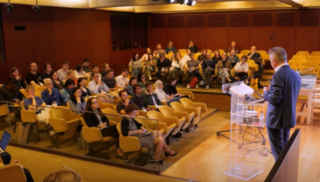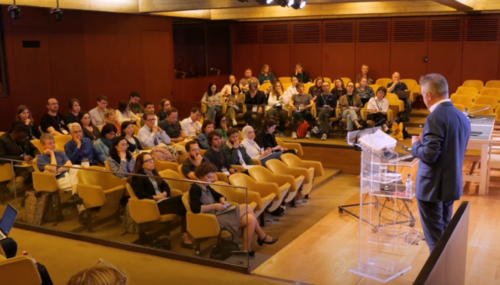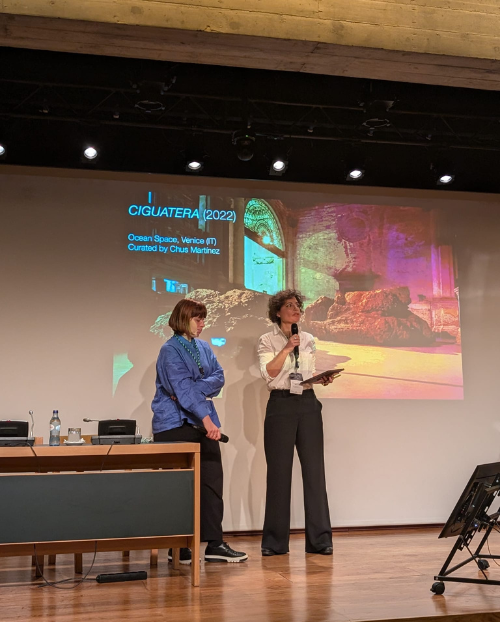Climate change is not just a planetary-scale issue, but also a cellular-scale one. In a recent cross-disciplinary European Molecular Biology Organization (EMBO) meeting, scientists, policy makers, artists, and funders gathered to jumpstart an integrated cell-to-planet discipline and stress the need for new research alliances.
Tackling Climate Change at All Scales: Reflecting on the EMBO Kickstart Meeting
Content Capsule
Held April 13-16, 2025, at the Gulbenkian Foundation in Lisbon, EMBO brought together experts in a wide array of disciplines to discuss how microscale processes influence — and are influenced by — macroscale environmental shifts. The discussions highlighted that real progress requires a systems-thinking approach, from cell-level mechanisms to global ecosystems. In addition to lectures, roundtable discussions mixed early career scientists, senior scientists, and funders. The outcomes of these conversations are being integrated into a roadmap for building a new field, “Planetary Cell Biology,” and a movement called, “Cells for Planetary Health.”
Rising global water temperatures and water pollution are two examples of environmental stressors that are becoming more prevalent due to climate change. Recognizing the deep, intertwined, and undeniable connections between human health and the health of ecosystems, the transdisciplinary concept “One Health” takes a holistic approach to the understanding of public health. In a nutshell, if we live in an ill environment, the risk of becoming ill ourselves is higher and the consequences might not only affect us, but also the other living creatures we share the planet with.
By fostering an integrative vision of diverse disciplines (such as medicine, animal health, environmental science, and social sciences), One Health aims to move beyond reactive responses to disease and toward unified prevention strategies. Inspired by this vision, scientists across different areas can mobilize their research into action, exploring a wide range of questions such as:
- How can we collectively understand what we are already modelling in isolated, siloed research paths
- How can we integrate fundamental scientific understanding with public health guidance?
- Can we build a world where interdisciplinarity nurtures emerging fields and cohesive discourse?
EMBO organized a one-of-a-kind workshop with the intention of building a framework that will encompass the various scales and models of climate change’s consequences. Proposing a unifying field name for this emerging narrative, “Planetary Cell Biology” unfurls the sails for interactions that will provide an integrated view from molecules to ecosystems, from public heath to alternative food production systems, and many more scale-leaping intersections.

Jeremy Farrar and the audience. (Photo: EMBO media team)
The opening keynote lecture by Jeremy Farrar, Chief Scientist at the World Health Organization (WHO), invited scientists to dare to bridge the gap between policy making and research.
“We need to focus on community, curiosity, interdisciplinarity, equity, and communication,” he said during the seminar. “To make a meaningful impact in years to come, we need policy makers that know the language of science and scientists that know the ways of policy making.”
The research directions described below might appear distant from each other at first, but they all aim to answer the great question: how does climate change impact life? Could mixing Yale RNA specialist Karla Neugebauer with experts in coral reef biology like Phillip Cleves lead to finer detail in our understanding of animal-microbe interactions that underlie coral bleaching? Could bringing Paula Duque’s knowledge in plant stress closer to Mavis Owusuaa Osei-Wusu’s sovereign quest for an African resilient rice catalyze this endeavor? Beyond the hard sciences, could inclusion of artistic works like Diana Policarpo’s Ciguatera in scientific meetings offer a compelling way to communicate the profound, shared impact of climate change?
Bringing together seemingly disparate topics, including highlighting how science and art intersect in shaping cultural understanding, is a critical step toward creatively solving urgent planetary challenges. It is in these kind intersections that we hope to see Planetary Cell Biology thrive!
Throughout the course of the meeting, many disciplinary and research area combinations were proposed that might inspire innovative solutions:
Who said that molecular biology can’t help us understand coral bleaching? Phillip Cleves’ research (Carnegie University) established new model organisms for deciphering the key elements in animal-microbe interactions, whose loss leads to coral bleaching. In jaw-dropping videos he shared their success in spawning reef-forming corals in aquario instead of their natural habitat, making research with these organisms more accessible. Yale faculty Karla Neugebauer shared her research on how unicellular algae react in their transcriptome to heat shock or heat acclimation. The aim of this research is to understand how RNA is a first responder of temperature changes, encompassing the heat shock response -a well-studied pathway- and innovating in exploring heat acclimation cellular processes that prepare the cells for change. Could RNA biology be involved in the genetic and molecular pathways to establish (and maintain) symbiosis in coral reefs? And, reciprocally, is RNA involved in the biological mechanisms that drive bleaching? Bringing these worlds together will not only bring a much-needed diversity to the field -mainly focused on model species such as human cell lines, yeast or fruit flies- but also new tools for remediation, harnessing the full potential of RNA technologies.
Plant biology can help us build equity in food supply chains. Mavis Owusuaa Osei-Wusu (West Africa Centre for Crop Improvement) is developing climate resilient rice. The director of this center, Eric Danquah, called out the need for regional governments to empower local scientific researchers in the quest of innovation autonomy, and shared their efforts in developing enhanced varieties of non-conventional local crops (bambara, taro, amaranth, okra, among others).
Marine life is also highly impacted by ever-growing human activity, and little is known on how aquatic ecosystems react to percolating pesticides. Flora Vincent’s lab (EMBL) bridges the ecosystem and laboratory scales working with ecologically relevant diatoms and their surrounding microbiome.
Is it possible to directly connect biochemistry with the environment from which it arose? Martina Preiner (Max Planck Institute for Terrestrial Microbiology) addresses this question, working to understand ancestral chemical mechanisms of CO2 fixation. Knowing “past” chemical, biological, or geological fixation pathways could help us improve modern carbon capture through engineering synthetic pathways in other organisms.
Ron Milo’s research (Weissman Institute) uses synthetic biology approaches to build CO2 fixation pathways in bacteria, while also analyzing the techno-economic viability of current alternatives to food production systems. Even though advances in bioreactor-based production are promising, a significant gap remains in understanding when and where these new processes can economically -and environmentally- compete with existing methods. In a freshly published paper they conclude that electro-microbial biomass production is a promise for food production, but not for fuel production. Likewise, using building blocks from the “solution space explored by Nature,” Tobias Erb focuses on the design and engineering of new options in carbon capture, leveraging the natural versatility of enzymes to apply their activity towards converting one-carbon substrates like CO2.
Diana Policarpo’s current exhibition, Ciguatera, at the Center for Modern Art in the Gulbenkian Foundation is the result from a long research interaction with scientists in the Selvagen Islands. The ciguatera food poisoning is the result of consumption of ciguatoxin-contaminated fish that have fed on dinoflagellates that produce the ciguatoxins. Ciguatera appears in Homer’s Odyssey and could have been the cause of ancient Polynesian islanders’ migrations to conquer new and safer fishing areas. Our changing climate and environmental conditions might lead to new areas of dinoflagellate blooms, causing the limits of the ciguatera cases to shift abnormally. This art-science interaction results not only in beautiful installations and films, but also in a participative and immersive cultural awareness of climate change’s impacts.
Graça Carvalho, Portugal’s Minister of Environment and Energy had a strong research education before her path into politics, receiving her PhD from the Imperial College London. During the meeting’s closing remarks, she stated that the methods for analyzing data and decision making she learned during her academic years accompany her decision-making processes to this day. Her administration takes pride in having achieved 71% of Portugal’s energy production from renewable sources and encouraged the whole audience to make open science and open innovation for the world.



EMBO Group Photo
Meeting participants gather for a group photo. (Photo: EMBO Media team)
Keynote Lecture
Jeremy Farrar and the audience. (Photo: EMBO media team)
Martina Preiner, Max Planck Institute for Terrestrial Microbiology
Diana Policarpo and Monica Bettancourt-Dias (organizer). (Photo: Guillermina Kubaczka)
This meeting was one of a kind. The mix of disciplines did not just make space for open conversation—it felt natural to revisit big, basic questions. In this atmosphere of trust and curiosity, bold ideas flourished fueled by a shared sense of purpose and a willingness to listen, connect, and imagine new possibilities together. The long-term aspirations stemming from these interactions include incorporating the cellular scale into the global understanding of climate resilience, translating research into actionable solutions for field implementation, establishing a defined scientific area with dedicated outlets and sustained funding, building an inclusive international community focused on impactful climate research, and bringing scientific findings into policy conversations and public engagement.
Taking responsibility for man-made changes in our environment must include understanding the molecular mechanisms by which ecosystems will react. As a society, species, and living beings, we are subject to all the consequences of climate change in the same way as all these other forms of life. We are in a promising time in which we can focus our unprecedented ability to generate and analyze data to the inexorable consequences of climate change. Similarly, as when the molecular principles of cancer started to be discovered, with new knowledge comes new hope for new solutions for bioremediation, human health, biotechnology, and agriculture, among other serendipitous surprises humankind might find along the way.
Bringing these previously disconnected fields together is critical for solving the complex challenges of our time because they underscore how human health and climate health are, at the end of the day, just One Health.
Planetary Cell Biology is growing!
Climate change is not just a planetary-scale issue, but also a cellular-scale one.

Explore more content
tagline content